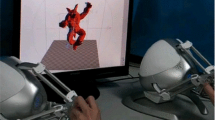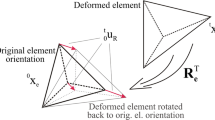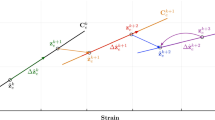Abstract
Simulation of physically based deformable models is a hot topic in computer graphics. Most of the existing models focus on isotropic materials and some on transversely isotropic materials. We propose a modeling method for orthotropic materials, which exhibits different mechanical behaviors along three orthogonal directions. First, constraints for the strain energy density in linear elastic models are analyzed, and a positive-definite elasticity tensor is derived for an orthotropic material. Second, an orthotropic deformation controlling frame-field is conceptualized and a frame construction tool is developed for users to define the desired material properties. A quaternion Laplacian smoothing algorithm is proposed, and several user-defined rotation minimizing frames are propagated into the entire body of the deformable object, which forms a smooth frame-field. Third, the corotational linear FEM model coupled with the orthonormal frame-field is formulated to realize a dynamics system, which can deal with large deformations. All the algorithms have been implemented in a comprehensive modeling and simulation system, and a GUI is provided to design the orthotropic model. Experiments on real-time deformation simulation and analytical comparisons are presented.








Similar content being viewed by others
References
Allard, J., Courtecuisse, H., Faure, F., et al.: Implicit Fem Solver on GPU for Interactive Deformation Simulation. GPU Computing Gems Jade Edition, pp. 281–294 (2011)
An, S.S., Kim, T., James, D.L.: Optimizing cubature for efficient integration of subspace deformations. In: ACM Transactions on Graphics (TOG), vol. 27, p. 165. ACM (2008)
Baraff, D., Witkin, A.: Large steps in cloth simulation. In: Proceedings of the 25th annual Conference on Computer Graphics and Interactive Techniques, pp. 43–54. ACM (1998)
Barbič, J., James, D.L.: Real-time subspace integration for st. venant-kirchhoff deformable models. In: ACM Transactions on Graphics (TOG), vol. 24, pp. 982–990. ACM (2005)
Barbič, J., Sin, F.S., Schroeder, D.: Vega FEM Library (2012). http://www.jernejbarbic.com/vega
Bender, J., Müller, M., Otaduy, M.A., Teschner, M., Macklin, M.: A survey on position-based simulation methods in computer graphics. In: Computer Graphics Forum, vol. 33, pp. 228–251. Wiley Online Library (2014)
Bouaziz, S., Martin, S., Liu, T., Kavan, L., Pauly, M.: Projective dynamics: fusing constraint projections for fast simulation. ACM Trans. Graph. (TOG) 33(4), 154 (2014)
Cai, J., Lin, F., Lee, Y.T., Qian, K., Seah, H.S.: Incorporating Fiber Controls into FEM Model for Transversely Isotropic Materials. In: Keyser, J., Kim, Y.J., Wonka, P. (eds.) Pacific Graphics Short Papers. The Eurographics Association (2014). doi:10.2312/pgs.20141243
Choi, H.F., Blemker, S.S.: Skeletal muscle fascicle arrangements can be reconstructed using a laplacian vector field simulation. PloS one. 8(10), e77576 (2013)
Choi, M.G., Ko, H.S.: Modal warping: Real-time simulation of large rotational deformation and manipulation. Vis. Comput. Graph. IEEE Trans. 11(1), 91–101 (2005)
Cook, R., Malkus, D., Plesha, M., Witt, R.: Concepts and applications of finite element analysis. Wiley (2002)
Courtecuisse, H., Allard, J., Kerfriden, P., Bordas, S.P., Cotin, S., Duriez, C.: Real-time simulation of contact and cutting of heterogeneous soft-tissues. Med. Image. Anal. 18(2), 394–410 (2014)
Gilles, B., Faure, F., Bousquet, G., Pai, D.K.: Frame-based interactive simulation of complex deformable objects. In: Deformation Models, pp. 145–166. Springer (2013)
Huang, J., Shi, X., Liu, X., Zhou, K., Guo, B., Bao, H.: Geometrically based potential energy for simulating deformable objects. Vis. Comput. 22(9–11), 740–748 (2006)
Irving, G., Teran, J., Fedkiw, R.: Invertible finite elements for robust simulation of large deformation. In: Proceedings of the 2004 ACM SIGGRAPH/Eurographics symposium on Computer animation, pp. 131–140. Eurographics Association (2004)
Kavan, L., Collins, S., OSullivan, C., Zara, J.: Dual quaternions for rigid transformation blending. Trinity College Dublin, Tech. Rep. TCD-CS-2006-46 (2006)
Kavan, L., Žára, J.: Spherical blend skinning: a real-time deformation of articulated models. In: Proceedings of the 2005 symposium on Interactive 3D graphics and games, pp. 9–16. ACM (2005)
Kim, T., James, D.L.: Physics-based character skinning using multidomain subspace deformations. Vis. Comput. Graph. IEEE Trans. 18(8), 1228–1240 (2012)
Li, Y., Barbic, J.: Stable orthotropic materials. In: Symposium on Computer Animation (SCA), pp. 41–46 (2014)
Lipman, Y., Rustamov, R.M., Funkhouser, T.A.: Biharmonic distance. ACM Trans. Graph. (TOG) 29(3), 27 (2010)
Liu, N., He, X., Ren, Y., Li, S., Wang, G.: Physical material editing with structure embedding for animated solid. In: Proceedings of Graphics Interface 2012, pp. 193–200. Canadian Information Processing Society (2012)
Magnenat-Thalmann, N., Laperrire, R., Thalmann, D.: Joint-dependent local deformations for hand animation and object grasping. In: Proceedings on Graphics Interface 88. Citeseer (1988)
Martin, S., Thomaszewski, B., Grinspun, E., Gross, M.: Example-based elastic materials. In: ACM Transactions on Graphics (TOG), vol. 30, p. 72. ACM (2011)
McDonnell, K.T., Qin, H.: A novel framework for physically based sculpting and animation of free-form solids. Vis Comput 23(4), 285–296 (2007)
Müller, M., Chentanez, N.: Solid simulation with oriented particles. In: ACM Transactions on Graphics (TOG), vol. 30, p. 92. ACM (2011)
Müller, M., Gross, M.: Interactive virtual materials. In: Proceedings of Graphics Interface 2004, pp. 239–246. Canadian Human-Computer Communications Society (2004)
Müller, M., Heidelberger, B., Hennix, M., Ratcliff, J.: Position based dynamics. J. Vis. Commun. Image. Represent. 18(2), 109–118 (2007)
Müller, M., Heidelberger, B., Teschner, M., Gross, M.: Meshless deformations based on shape matching. In: ACM Transactions on Graphics (TOG), vol. 24, pp. 471–478. ACM (2005)
Nealen, A., Müller, M., Keiser, R., Boxerman, E., Carlson, M.: Physically based deformable models in computer graphics. In: Computer Graphics Forum, vol. 25, pp. 809–836. Wiley Online Library (2006)
Nvidia, D.Z.: Physx sdk. https://developer.nvidia.com/physx-sdk (2011)
Picinbono, G., Delingette, H., Ayache, N.: Non-linear anisotropic elasticity for real-time surgery simulation. Graph. Models 65(5), 305–321 (2003)
Picinbono, G., Lombardo, J.C., Delingette, H., Ayache, N.: Anisotropic elasticity and force extrapolation to improve realism of surgery simulation. In: Robotics and Automation, 2000. Proceedings. ICRA’00. IEEE International Conference on, vol. 1, pp. 596–602. IEEE (2000)
Shoemake, K.: Animating rotation with quaternion curves. In: ACM SIGGRAPH Computer Graphics, vol. 19, pp. 245–254. ACM (1985)
Sorkine, O., Cohen-Or, D., Lipman, Y., Alexa, M., Rössl, C., Seidel, H.P.: Laplacian surface editing. In: Proceedings of the 2004 Eurographics/ACM SIGGRAPH Symposium on Geometry Processing, pp. 175–184. ACM (2004)
Stomakhin, A., Howes, R., Schroeder, C., Teran, J.M.: Energetically consistent invertible elasticity. In: Proceedings of the ACM SIGGRAPH/Eurographics Symposium on Computer Animation, pp. 25–32. Eurographics Association (2012)
Takayama, K., Igarashi, T., Haraguchi, R., Nakazawa, K.: A sketch-based interface for modeling myocardial fiber orientation. In: Smart Graphics, pp. 1–9. Springer (2007)
Ten Thije, R., Akkerman, R., Huétink, J.: Large deformation simulation of anisotropic material using an updated lagrangian finite element method. Comput. Methods Appl. Mech. Eng. 196(33), 3141–3150 (2007)
Teran, J., Sifakis, E., Irving, G., Fedkiw, R.: Robust quasistatic finite elements and flesh simulation. In: Proceedings of the 2005 ACM SIGGRAPH/Eurographics Symposium on Computer Animation, pp. 181–190. ACM (2005)
Terzopoulos, D., Fleischer, K.: Deformable models. Vis. Comput. 4(6), 306–331 (1988)
Terzopoulos, D., Platt, J., Barr, A., Fleischer, K.: Elastically deformable models. In: ACM Siggraph Computer Graphics, vol. 21, pp. 205–214. ACM (1987)
Teschner, M., Heidelberger, B., Müller, M., Gross, M.: A versatile and robust model for geometrically complex deformable solids. In: Computer Graphics International, 2004. Proceedings, pp. 312–319. IEEE (2004)
Ting, T.C., Horgan, C.: Anisotropic elasticity: theory and applications. J. Appl. Mech. 63, 1056 (1996)
Volino, P., Magnenat-Thalmann, N., Faure, F.: A simple approach to nonlinear tensile stiffness for accurate cloth simulation. ACM Trans. Graph. (TOG) 28(4) (2009)
Wang, H., O’Brien, J.F., Ramamoorthi, R.: Data-driven elastic models for cloth: modeling and measurement. ACM Trans. Graph. (TOG) 30(4), 71 (2011)
Wang, W., Jüttler, B., Zheng, D., Liu, Y.: Computation of rotation minimizing frames. ACM Trans. Graph. (TOG) 27(1), 2 (2008)
Wood, W.: Practical Time-stepping Schemes, vol. 6. Clarendon Press, Oxford (1990)
Xu, H., Sin, F., Zhu, Y., Barbič, J.: Nonlinear material design using principal stretches. ACM Trans. Graph. (TOG) 34(4), 75 (2015)
Acknowledgments
Tetrahedral meshes of the fish model and the hosta model are generated by the PhysXViewer included in NVIDIA PhysX SDK (v2.7.3) [30]. The raptor model (both the surface and tetrahedral mesh) is obtained from the demo of the paper [1]. The implementation is based on VegaFEM. This work is partially supported by the grants, MOE ARC 4/12 and RG139/14, and by the Singapore National Research Foundation under its IDM Futures Funding Initiative and administered by the Interactive & Digital Media Programme Office, Media Development Authority.
Author information
Authors and Affiliations
Corresponding author
Rights and permissions
About this article
Cite this article
Cai, J., Lin, F., Lee, Y.T. et al. Modeling and dynamics simulation for deformable objects of orthotropic materials. Vis Comput 33, 1307–1318 (2017). https://doi.org/10.1007/s00371-016-1221-4
Published:
Issue Date:
DOI: https://doi.org/10.1007/s00371-016-1221-4




